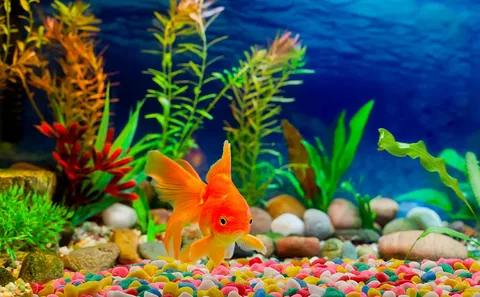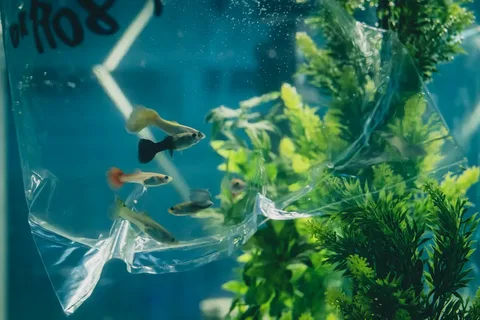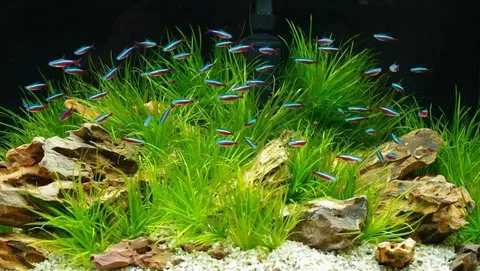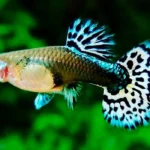Signs of Stress are one of the largest unseen threats in aquariums, tending to cause disease, aggression, and even mortality if not addressed. To recognize the symptoms of stress and how to act on them is important to any good fish keeper, whether you are a one-fish, desktop-tank setup owner or a massive reef tank sitter. In this guide, we will be covering all that you need to know to recognise, avoid, and cure stress in your aquatic pets.

What Are Signs of Stress in Fish?
Although one isolated stress incident (like during a water change) may be harmless, chronic Signs of Stress is perilous. It compromises their immune system, makes them prone to parasites and infection, changes their behavior, and shortens their lifespan.
Common causes of stress include
Poor water quality (high ammonia, nitrite, or nitrate levels)
Improper temperature
Overcrowding
Incompatible tank mates
Inadequate diet
Lack of hiding places
Frequent environmental changes
Bullying or harassment from other fish
Disease or injury
Every cause generates an unseen ripple effect within your fish’s body, resulting in physiological and behavioural alterations, most of which are simple to detect once you learn what to search for.
Physical Signs of Stress in Aquarium Fish
Signs of Stress rarely shout. It whispers.
The following are some of the most frequent physical signs that your fish could be in danger:
Rapid Gill Movement or Gasping at the Surface
Fish breathe via gills. If they’re working overtime, it’s usually an indication of:
Poor oxygen levels
High ammonia or nitrite
Temperature stress
Disease affecting the gills (like parasites)
Fish gasping at the surface of water are attempting to gain access to more oxygen — a desperate and worrisome indication.
Color Fading
Colourful fish will usually become pale when under stress.
Dull, pale, or even blotchy color is your fish’s way of communicating distress, either from environmental problems or internal disease.
Clamped Fins
Fins should be spread apart, assisting the fish in balancing and maneuvering.
Clamped fins (held tightly against the body) suggest a withdrawn, uneasy fish— a standard indicator of stress.
Spots, Lesions, or Sores
Although bodily injuries can be caused by combat, numerous skin problems are stress-related:
White spots (ich)
Red sores (bacterial infections)
Fungal growth
Inflamed scales (dropsy)
Erratic Swimming
Observe how your fish swims.
Darting around suddenly
Banging into glass
Floating upside down
Spiraling
These are not mere strange idiosyncrasies; they’re indicators that something is critically amiss internally or externally.

Behavioral Signs of Stress in Aquarium Fish
At other times, it’s not the body but the action that indicates stress. Observe these tendencies:
Hiding Constantly
Fish must exhibit natural hiding behavior, but if an otherwise social fish hides all day, something is wrong. Being frightened by a predator, being bullied, or tank conditions can cause fish to hide.
Aggression
Some are naturally territorial, but a sudden increase in aggression may be a sign of stress.
Fish will attack other tank inhabitants or even “glass” surf, cruising along aquarium walls through.
Common Stress Triggers and How to Fix Them
Identifying stress is step one. Step two? Locating and correcting the root cause.
Poor Water Quality
Problem
Ammonia, nitrite, and nitrate accumulation rapidly render the water poisonous.
Solution
Test water weekly
Perform regular water changes
Use a properly sized filter
Avoid overfeeding
Incompatible Tank Mates
Combining docile species with hostile ones results in a battleground.
Problem
Intergrouping the peaceful species and the aggressive species makes a battleground.
Solution
Research fish compatibility before adding new species
Provide separate territories
Remove bullies immediately
Overcrowding
Problem
More fish = not enough oxygen, room, or resources.
Solution
Follow the “one inch of fish per gallon” rule (for small community fish)
Upgrade tank size if needed
Rehome excess fish
Improper Temperature
Problem
Different species have ideal temperature ranges. Temperature fluctuations put stress on immune systems.
Solution
Invest in a reliable aquarium heater
Monitor temperature daily
Quarantine new fish in temperature-matched tanks

Stress-Specific Situations and Solutions
New Tank Syndrome
Newly cycled tanks possess erratic water parameters that stress fish.
What to do
Cycle your tank fully before adding fish
Add fish slowly over weeks, not all at once
Monitor ammonia and nitrite levels closely
After a Move or Water Change
Even beneficial changes can be stressful.
What to do
Match the temperature and ph during water changes
Handle fish gently when moving them
Minimize disruption
Disease Outbreaks
Disease and stress fuel each other.
What to do
Quarantine new fish for 2-4 weeks
Treat diseases promptly
Boost immunity with high-quality foods and stable water conditions
When to Seek Professional Help
At times, regardless of our attempts, a fish’s stress indicators deteriorate.
If you see extreme physical symptoms (such as bloating, fuzzy growths, bleeding, or extreme lethargy) and can’t fix them in a hurry, it’s time to call in a vet who specialises in fish (yes, they do exist!).
Aquarium stores will also give advice, but be careful — not all advice is equal.
Always cross-check advice with reputable sources or experienced aquarists.

Conclusion
Having fish is more than keeping a glass box of water — it’s caring for life.
When stress comes to aquarium fish, the body sends out the initial alarm signals long before changes in behavior. Fading color, clamped fins, gasping, or frantic swimming are not merely surface problems — they are desperate signals that something is amiss beneath. Signs of Stress.
Our role as fish keepers is to become conversant in this silent language.
By noticing and acting fast upon these physical indicators, we not only avoid suffering but also produce a healthier, Signs of Stress more lively aquarium where fish can really flourish.
In the hobby of fishkeeping, a small observation can make the difference between life and death.
Their tranquillity is not by chance. Signs of Stress are the product of your attention, your diligence, and your affection. And that’s the real pleasure of fishkeeping.
FAQs
How can I tell if my fish is stressed or just acting normally?
Fish do possess personalities, but extreme changes in behaviour or looks typically indicate stress. Watch for obvious warning signals such as held-back fins, labored breathing, fading colors, constant hiding, or lack of appetite. Trust your intuition — if it doesn’t “feel” right, it’s worth checking out.
How quickly does stress affect fish health?
It varies. Acute stress (such as a sudden ammonia buildup) will kill them in hours if severe. Chronic stress (due to poor conditions over several weeks) slowly saps their immune system, leaving them susceptible to disease and a reduced lifespan. In either situation, stress must always be resolved promptly.
What’s the fastest way to reduce fish stress?
Start with their environment
Test and fix water parameters immediately (ammonia, nitrite, nitrate, pH).
Stabilize the temperature.
Add extra hiding places like caves or plants.
Dim the lighting for a few days.
Sometimes, just improving water quality and offering a stress coat water conditioner can make a huge difference quickly.
Should I isolate a stressed fish?
Only when they are being bullied, have contract a contagious disease, or are looking seriously sick.
Otherwise, relocating a stressed fish can further worsen the situation. Always weigh the risks with care — at times, it is preferable to correct the tank environment rather than relocate the fish.
Can overfeeding cause stress?
Yes! Overfeeding causes dirty water (ammonia spikes), obesity, digestion issues, and decreased water oxygen — all of which stress the fish. Feed small amounts they can consume in 2–3 minutes, once or twice daily, depending on species.
Is stress visible in all fish species in the same way?
Betta fish may float listlessly or refuse food.
Cichlids may become hyper-aggressive.
Goldfish may sit at the bottom and gasp.
How often should I check my fish for signs of stress?
Ideally, short daily inspections are optimal.
Take a few minutes every day to watch your fish at feeding time. Check for physical changes, energy levels, and social behavior. Early detection can save lives, and most often makes treatment much simpler.










